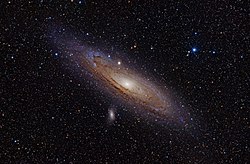Messier 110
| Galaxie Messier 110 | |
|---|---|
 | |
| Aufnahme mithilfe eines Spiegelteleskop des Kitt Peak National Observatory mit einer Öffnungsweite von 0,9 Meter | |
| AladinLite | |
| Sternbild | Andromeda |
| Position Äquinoktium: J2000.0, Epoche: J2000.0 | |
| Rektaszension | 00h 40m 22,1s[1] |
| Deklination | +41° 41′ 07″[1] |
| Erscheinungsbild | |
| Morphologischer Typ | E5 pec[1] |
| Helligkeit (visuell) | 7,9 mag[2] |
| Helligkeit (B-Band) | 8,9 mag[2] |
| Winkelausdehnung | 19,5′ × 11,5′[2] |
| Positionswinkel | 170°[2] |
| Flächenhelligkeit | 13,8 mag/arcmin²[2] |
| Physikalische Daten | |
| Zugehörigkeit | Lokale Gruppe, LGG 11[1][3] |
| Rotverschiebung | −0.000804 ± 0.000010[1] |
| Radialgeschwindigkeit | −(241 ± 3) km/s[1] |
| Hubbledistanz H0 = 73 km/(s • Mpc) | (3 ± 0) · 106 Lj (0,821 ± 0,065) Mpc [1] |
| Masse | 3,6 · 109 bis 15 · 109 M☉ |
| Durchmesser | 15.000 Lj[4] |
| Geschichte | |
| Entdeckung | Charles Messier Caroline Herschel |
| Entdeckungsdatum | 10. August 1773 27. August 1783 |
| Katalogbezeichnungen | |
| M 110 • NGC 205 • UGC 426 • PGC 2429 • CGCG 535-014 • MCG +07-02-014 • IRAS 00376+4124 • GC 105 • H V 18 • h 44 • LDCE 0031 NED005 | |
Messier 110 (auch als NGC 205 bezeichnet) ist eine elliptische Galaxie mit den Abmessungen 19,5' × 11,5' im Sternbild Andromeda. Sie ist ein Begleiter von Messier 31, dem Andromedanebel, und wie dieser 2,7 Millionen Lichtjahre entfernt. Messier 110 wird heutzutage als sphärische Zwerggalaxie klassifiziert. Ihre Masse wird auf 3,6 bis 15 Milliarden Sonnenmassen geschätzt. Sie hat einen Halo mit acht Kugelsternhaufen.
Neben Messier 32 ist Messier 110 die zweite hellere Begleitgalaxie des Andromedanebels und somit ein Mitglied der Lokalen Gruppe.
Entdeckung
Messier 110 wurde am 10. August 1773 vom französischen Astronomen Charles Messier entdeckt, 1798 in einer Veröffentlichung beschrieben und 1807 auf einer Zeichnung des „Großen Andromeda Nebels“ bildlich festgehalten. Aus unbekannten Gründen hat er dieses Objekt jedoch nie in seinen Katalog aufgenommen. Die „offizielle“ Aufnahme in den Messier-Katalog erfolgte 1966 durch den Wissenschaftshistoriker K. Glyn Jones.[5]
Die deutsche Astronomin Caroline Herschel entdeckte Messier 110 unabhängig von Charles Messier am 27. August 1783 – von ihrem Bruder Wilhelm Herschel erhielt er dann die Nummer H V 18.
Literatur
- König, Michael & Binnewies, Stefan (2019): Bildatlas der Galaxien: Die Astrophysik hinter den Astrofotografien, Stuttgart: Kosmos, S. 291
Weblinks
- Dwarf Elliptical Galaxy NGC 205 in the Local Group – Astronomy Picture of the Day vom 23. Oktober 2000 (englisch).
- CDS Portal
- Not So Dead After All
- M110 bei SEDS (englisch und deutsch)
Einzelnachweise
Auf dieser Seite verwendete Medien
Bildtafel der 110 Messier-Objekte. Diese Datei wird in der w:de:Template:Navigationsleiste Messierobjekte als Imagemap genutzt. Sie darf daher nicht durch eine andere Version überschrieben werden!
Autor/Urheber: Adam Evans, Lizenz: CC BY 2.0
Die Andromedagalaxie ist eine Spiralgalaxie im Sternbild Andromeda (etwa 2,4 bis 2,9 Millionen Lichtjahre entfernt). Das Foto zeigt auch die Messierobjekte 32 und 110 sowie NGC 206 (eine helle Sternassoziation in der Andromedagalaxie) und den Stern ν Andromedae. Kombination von LRGB- und Hα-Bilddaten.
Autor/Urheber: Credit:NOIRLab/NSF/AURA, Lizenz: CC BY 4.0
M110, NGC 205
M110 is the second small companion (along with M32) to our sister galaxy, M31, the Andromeda Nebula. It is classified as type E5 or E6, often with the additional "p" for peculiar because of the structure clearly visible in this short exposure image, which is probably due to dust clouds. Because of its small size, it is usually counted as a dwarf spheroidal rather than a normal elliptical. Although it was definitely discovered by Messier and sketched by him, it was not included in his list (perhaps due to carelessness), and was the last object to be added (in 1966). The present picture is a color composite of CCD images from the 0.9-meter telescope of the Kitt Peak National Observatory, near Tucson, Arizona. A deeper exposure showing more of the outer regions of the galaxy appears in this picture of all three of M31, M32 and M110.
(c) ESA/Hubble, CC BY 4.0
Many of the best-loved galaxies in the cosmos are remarkably large, close, massive, bright, or beautiful, often with an unusual or intriguing structure or history. However, it takes all kinds to make a Universe — as demonstrated by this Hubble Picture of the Week of Messier 110.
Messier 110 may not look like much, but it is a fascinating near neighbour of our home galaxy, and an unusual example of its type. It is a member of the Local Group, a gathering of galaxies comprising the Milky Way and a number of the galaxies closest to it. Specifically, Messier 110 is one of the many satellite galaxies encircling the Andromeda Galaxy, the nearest major galaxy to our own, and is classified as a dwarf elliptical galaxy, meaning that it has a smooth and almost featureless structure. Elliptical galaxies lack arms and notable pockets of star formation — both characteristic features of spiral galaxies. Dwarf ellipticals are quite common in groups and clusters of galaxies, and are often satellites of larger galaxies.
Because they lack stellar nurseries and contain mostly old stars, elliptical galaxies are often considered ‘dead’ when compared to their spiral relatives. However, astronomers have spotted signs of a population of young, blue stars at the centre of Messier 110 — hinting that it may not be so dead after all.





